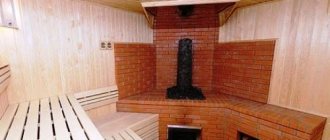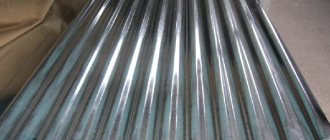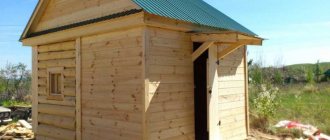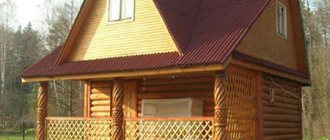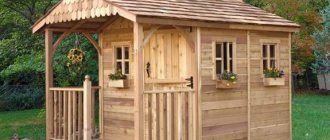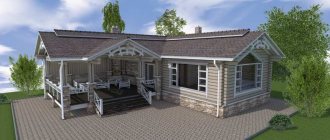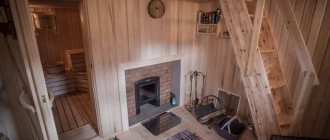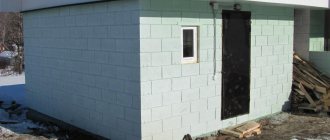Unlike conventional saunas and steam rooms, the construction of a hammam requires a very balanced and precise approach when choosing finishing materials, heating and ventilation systems. Therefore, not every project for the construction of a Turkish hammam bath can be taken as a basis; here it is better to do without homemade products, choose the best solution, and, if possible, buy ready-made ventilation and heating equipment.
The original Turkish hakama is very beautiful
Turkish bath hammam: velvety warmth. We build with our own hands according to the rules
Hammam, which came from Turkey, is a descendant of ancient Roman baths.
Having elevated cleanliness to a religious dogma, Islam made a weekly trip to the bathhouse obligatory, and the mild climate of Islamic countries, which did not require warming up to the bones, turned the bathing procedure into a pleasure. According to the Russian Spelling Dictionary of the Russian Academy of Sciences / Ed. V. V. Lopatina, O. E. Ivanova. M., 2012, spelling the word “hammam” is considered incorrect, correct: “hammam”.
The classic hammam was built of stone
The main differences between a hammam and other types of baths:
- Gentle temperature;
- Humidity above 70%;
- Separate room for equipment;
- Stone cladding and furniture;
- Heating of floors, walls and sunbeds;
- A massage table
- Domed or arched ceiling;
- Forced ventilation with 4-fold exchange.
Let's consider these features in detail.
Temperature
The hammam differs from the Russian bath and Finnish sauna in its comfortable temperature of 30 to 55 ° C and 100% humidity. The gentle temperature is especially pleasant for people who do not like or cannot be in a steam room with a high temperature.
Humidity
Initially, steam for the hammam was obtained by boiling water in huge vats, and then supplied through pipes to the steam room. Now steam is produced using steam generators, which take up little space. The condition for placing the steam generator is no further than 15 meters from the steam room.
Equipment room
Separate placement of equipment is justified: nothing should interfere with the enjoyment of the procedure and the relaxation of the steamer; safety is also important - the proximity of naked people to boilers of boiling water.
Stone for cladding
Initially, the outline of the hammam premises was made of stone - marble or granite. Since the sun loungers are heated to body temperature or slightly higher, lying on them is comfortable. However, the cost of natural stone and processing is high; stone is replaced with ceramic tiles or mosaics.
Heating of walls, floors and sunbeds
To place a steam room in a hammam, heating of the floor, walls and sun loungers is provided using underfloor heating systems, water, electric or film (infrared).
A massage table
Traditionally, a soap massage is performed in a Turkish bath, which has a relaxing effect. To perform a massage, a massage table for several people is installed, initially also made of stone, heated.
Curved ceiling
A ceiling in the form of a dome or arch is made in the hammam so that condensation from steam settling on the surface of the ceiling does not drip down onto the people lying down, but slowly flows down the walls.
Question: what do a hammam and a regular steam room have in common? The answer: that both there and there visitors enjoy!
Scheme of heating and heat distribution in a Turkish hammam
The classic oriental bathhouse has one peculiarity: it is not heated on purpose. Even at the construction stage, special channels are made in the walls and floor for the circulation of hot mineral water, which is used to heat the room and fill the bathtub or bathhouse inside the bathhouse.
In a modern Turkish hammam for personal use, the floor, beds and bathing area inside the bathhouse must be heated using built-in hot water channels. In this case, the coolant selection must be carried out and regulated from a separate heating circuit.
A modern way to heat the walls and floor of a bathhouse
Important! The temperature inside the hammam usually does not exceed 50-55°C, so during construction it is necessary to look for optimal options for heating the floor and beds so that the temperature of the ceramic surface does not exceed 35-40°C.
Directly running hot water from the heating circuit of the house is allowed only at the stage of warming up the hammam room. Next, you have to reduce the temperature of the coolant and regulate it either manually or with a built-in automatic tap.
Benefits and harms
Both specialists and novice lovers of wet steam talk a lot about whether a hammam is needed and whether it is useful for children and adults. This bathhouse works a little differently than the Russian steam room and Finnish sauna. But its benefits are absolutely undeniable and are as follows.
Detoxifying effects. The special atmosphere of the hammam ensures full opening of pores, removal of toxins, and provokes sweating.
It is worth paying attention to the fact that with prolonged and regular exposure to wet steam, the skin condition actually improves, acne and pimples disappear, and tone increases. After visiting the Turkish bath, the tan is preserved, looks more even, and applies better.
Weight loss
Your own home hammam allows you to provide more effective effects of lymphatic drainage and massage procedures. With its help, it is possible to remove cellulite and reduce volume. It cannot be said that a Turkish bath greatly accelerates weight loss, but it definitely helps to make it much more pleasant and comfortable, and ensures that the results are consolidated.
Reducing skin oiliness. Increased secretion of the sebaceous glands causes a lot of problems. By regularly undergoing the procedure with wet steam, you can achieve narrowing of pores and normalize many processes in the body. The condition of the skin and hair becomes significantly better, and excess oiliness is eliminated.
Fighting colds. In the absence of elevated body temperature, a Turkish steam room can be considered an integral part of successful treatment. In the hammam you can conduct aromatherapy sessions, ensure uniform heating of the respiratory organs, as when placing cups and mustard plasters, but do this in a complex manner. Such a home steam room will be a really good solution for children who are not too fond of medical procedures.
Relaxation and anti-stress. A visit to the hammam promotes deep muscle relaxation, helps get rid of tension and excessive release of lactic acid. It is this method of relaxation that ensures a successful fight against fatigue, overwork, and depression. Even with severe stress, a couple of hours in the hammam will help bring your mind and feelings into balance and relieve feelings of anxiety and tension.
Relieving joint pain. The Turkish bath with its soft, delicate warmth provides a beneficial effect on the condition of the musculoskeletal system in case of arthritis, arthrosis, and osteochondrosis. Recovery from injuries and fractures and the fight against salt deposits in such conditions is faster and more effective. You can consider visiting the complex as part of physiotherapy.
Fighting chronic respiratory diseases. Bronchitis, tonsillitis, laryngitis, which constantly arise against the background of colds, can disappear completely and without a trace if you make regular visits to the Turkish bath a healthy habit. Wet steam combined with heating and the use of aromatic oils works better than any physiotherapy. At the same time, the person enjoys the procedure and has a pleasant time.
The harm of a Turkish bath is directly related only to individual restrictions set for specific people. For example, it is prohibited to carry out procedures with steam if a person is in an acute painful condition: with an increase in body temperature, the development of inflammatory processes, or the presence of chronic diseases in the acute phase. Visiting the bathhouse is also prohibited if there are tumors of any type in the body - benign, malignant. A pathogenic neoplasm can begin to grow as heating provokes cell division.
You should not visit the hammam while pregnant. Such procedures are prohibited for people with lung diseases: tuberculosis, bronchial asthma. You should not visit a Turkish bath after a heart attack, stroke, or if you have problems with blood vessels, the endocrine system, or liver disease.
Construction and exterior finishing materials
Now that we've left the living room, it's time to discuss what the building looks like from the outside. It will not be a revelation to anyone to say that such objects should not only be heated efficiently, but also be warm in themselves. And the best material for this is comfortable, cozy, hygroscopic and environmentally friendly natural ceramic brick. That’s why various projects of brick baths – with terraces, verandas, swimming pools and others – are so in demand among our clients.
We did not reinvent the “construction bicycle” and designed the hammam bathhouse from just such bricks. Moreover, there is already a brick house on the site - and our bath complex is in perfect harmony with it.
For the exterior design, dark facing brick was chosen, which we successfully combined with artificial cement stone with an uneven, torn surface. The base and walls are finished with it.
The pitched roof will be covered with brown tiles. Its deliberate restraint and laconicism are somewhat diluted by chimneys decorated with elegant forged decor.
The picture is completed by generous glazing: glass doors, panoramic and sash windows provide the premises with sufficient natural light.
Our team had to work a lot. But the result was worth it: the project of a brick bathhouse with a hammam turned out to be elegant, elegantly restrained, very practical and at the same time warm and cozy at home. This is the customer’s opinion, with which we completely agree.
The history of hammams
The Roman baths impressed the Arabs so much that they began to build the same ones, but taking into account religious views. And so the first hammam appeared on the shores of the Red Sea. After which steam baths spread throughout all Islamic territories. The Arabs excluded from their baths a large pre-bath area, where the Romans had a library, stadium, and club.
Roman baths
Five rooms with different temperatures and a large round stone in the center of the hammam are also Arab innovations. Various temples, the decoration of which was luxurious, were used as hammams. This can be observed to this day.
A little later, the idea of hammams was adopted by the Turks, and the baths became “Turkish”. With the development of Islam, hammams spread towards Asia. At the same time, the rituals of the Turkish bath were enriched, new features appeared in the form of multi-stage ablution, massage, and cosmetic procedures. As a result, hammam baths became a place not only for washing, but also for rest, relaxation, and wellness treatments.
What else is included in the design of a bathhouse with a hammam?
It is logical that the operation of the bath complex requires complex technical support. In our case, this is a boiler, a mini-electric boiler and a fairly powerful steam generator. They are collected in one technical room with a separate entrance from the street.
Our Russian bathhouse with hammam also has one more exit - from the living room. Passing through the wide sliding doors, we find ourselves on a large porch-veranda with a barbecue, a wooden table and the same benches. Here you can enjoy dining al fresco in good weather, surrounded by exotic green spaces. A great way to cool down after bathing and washing procedures! And if it suddenly rains and winds, just close the windows and doors.
The origins of the ancient tradition
The first baths in Turkey began to be built at the beginning of the 17th century. If we turn to the chronicles, the Turks adopted their first experience in maintaining personal hygiene from the Arabs, and they received their secrets from the ancient Romans. Many historians provide quite convincing evidence in favor of the fact that the hammam became a unique national variation of the Roman baths.
Interest in hammam baths began to increase at the time when Islam came to eastern countries. The baths became so popular that sometimes ancient temples of other religions were even converted into them. It was necessary to carry out rather labor-intensive work to re-equip the premises in order to comply with the requirements of multi-stage procedures. They were changed to such an extent that the baths in every detail exactly corresponded to the Turkish style.
Continuing to get acquainted with the history of the hammam, you can find out that the first examples of these baths did not have significant advantages. But the years passed, and traditions of visiting Turkish baths gradually formed. A clear confirmation of this was the steam room, which turned into a place for massage. This was an innovation for the hammam - there was no such thing in the Roman baths. The necessary changes were made to the dry steam room, as a result of which it turned into a “sweating room”.
Today, in our country, you can find Turkish hammams, but, as happened with other types of baths, these were just clones, unable to provide the required effect. Therefore, if you want to feel the bliss of visiting a real hammam, then you should go to Istanbul or Bukhara, where classic hammams are still preserved. In these cities, long-term buildings still continue to function, which the owners monitor and do not even think about making changes to them.
Hammam design
Usually the hammam is made in two colors: pastel (different shades of brown) or blue (different shades of blue). They don’t make a red hammam, because the red color does not allow you to relax and, as practice shows, people who chose red tones in the hammam already at the stage of choosing tiles refuse this decision. Therefore, we do not step on this rake and do it without mistakes.
They also try not to use green colors due to associations with moss and algae, it is humid in the hammam and, as practice shows, after 3-6 months people usually change the green color of the tiles to pastel or heavenly. But in any case, it's up to you to decide. Tiles are the final stage, and ultimately, which tile to choose for the hammam is up to you! You can make any shape of sunbeds, floors, domes, kurnas, but you need to understand that if you want to build a hammam cheaply, you will have to abandon individual solutions. Creating a custom-made sunbed is possible and is not expensive, but it takes time and in any case will be more expensive than a standard solution. Let's return to the stages of installing a hammam in an apartment or house.
Hammam: visiting rules
Photo from the website golden-hammam.ua
To get only pleasant emotions and maximum health benefits from visiting a hammam, you need to know how to properly go to a Turkish bath: how to steam in a chebek, use peelings or cosmetics, and how long you need to stay in the hammam.
First of all, before starting various massage procedures, you should sweat thoroughly. To do this, lie down or sit on a lounger for 20-30 minutes, which is previously covered with a cloth. The body is steamed, and all the pores are opened, so after about 30 minutes you need to start various types of massage. In a real Turkish bath he is quite energetic and sometimes even tough. Strong movements accelerate the blood, rub the whole body, which allows you to restore flexibility to the joints and stretch the muscles well.
Photo from the site m.slovenskenovice.si
After such manual therapy, you can lie down and relax for a while, or you can do peeling. To do this, use a hard glove to cleanse all dead and keratinized particles from the skin. The stage following peeling is a light soap massage. A bar of regular soap is placed in a mesh bag and shaken a little, resulting in a thick and soft foam. They cover the visitor from head to toe, and then begin to massage. After this, you can go to the relaxation room - there everyone will be offered to relax and drink a cup of herbal tea.
This is interesting!
When visiting a hammam, you need to remember that, unlike Russian and Finnish saunas, in such a Turkish bath, as a rule, there is no pool, since the Turks consider standing water unclean. Instead, there are several fountains in the steam room.
It is important to follow these recommendations:
- While visiting the hammam, it is prohibited to drink any alcohol or drink very cold drinks.
- It is better to limit yourself to tea, diluted juices, plain or rose water.
- There is no need to overeat before the bath. Ideally, more than 2 hours should pass after the last meal.
- Never make sudden movements in the steam room. This can be bad for warm muscles, as they are easily damaged in this state.
- It is not customary to go without clothes in such a bathhouse.
How does a classic hammam work?
A public Turkish bath is a huge building, all rooms of which are heated by one boiler. Hot air is supplied through pipes hidden under the floor, so visitors wore wooden slippers in the hammam. Steam escapes through holes in the walls.
Arrangement in Turkish styleSource statusmen.ru
The traditional bathhouse in Turkey was built in the shape of an open palm. The steam room consisted of 5 rooms, which were built in the form of rays around the main room:
- Jamekian. A locker room was set up in the dressing room.
- Peshtemal. The room was used for showering.
- Chebek. Room with hot beds. The structures were made of natural marble.
- Hararet. Thanks to the massage surfaces, the steam room combined functions with a treatment room.
- Keif. A room with tables and chairs for drinking tea and relaxing.
Entering the hammam, the visitor immediately found himself in a jamekian. Then he moved along the corridor into a huge round hararet. After the procedures, the person went into other rooms in which their temperature was maintained. The visitor could choose a comfortable temperature regime. Moist steam emanated from the surfaces, scented with fragrant oils.
Dome in the hammamSource sauna-parilka.ru
Communications were moved outside the rooms. Passing through the pipes, hot air transfers heat and humidity to the walls and floor. They steam in the hammam lying down, so a wide bed or platform with narrow models was placed in the center. The structure was made of marble or covered with tiles (mosaics). The height of the “furniture” is at least 80 cm.
Beautiful claddingSource turkishbath.com.ua
In the hararet, stone kurns with water must be installed. Massive containers do not have a drain; liquid is taken out using bowls. The classic Turkish steam room has three swimming pools. The first tank is filled with water, the temperature of which is +45 C. The second tank is filled with neutral liquid (+35 C), the third - cool. The interior features small waterfalls or marble fountains.
Ventilation is an essential component of a hammam. In traditional Turkish baths, a natural flow of air was organized, which was provided for when the building was founded. Aeration helped maintain comfortable conditions at high humidity.
Selection of building materials for the hammam
The construction of a Turkish bath is not something exceptional or complex in its design. The design of the hammam differs from the more familiar sauna or Russian steam room in only three factors:
- The use of ceramic wall cladding for the bathhouse, which is determined by high air humidity;
- Double layer of thermal insulation and waterproofing;
- Using a special device - a steam generator.
The hammam box is made of red brick or foam blocks. If the walls and ceiling are made of cast cinder block or concrete, you will need to additionally make vents to remove condensation that forms on the outside of the bathhouse box.
In rooms with concrete ceilings and walls, it is necessary to use mats with an applied layer of waterproofing
Furniture for hammam is almost always built inside the bathhouse from brick, plastered, covered with mastic waterproofing and lined with mosaic tiles.
The most important point in the construction of a hammam is the choice of waterproofing and insulation. Most often, insulation of the Ecover - Standard type is used; MopeLastik waterproofing, laid on aquapanels or waterproof plasterboard, is used as a water barrier.
Lux Elevations blocks
Advice! The construction of a hammam can be significantly simplified if you use ready-made panels to insulate the walls of a bathhouse with a high level of humidity. For example, polystyrene panels “Lux Elevments”.
The material has established itself as one of the best heat insulators for wet rooms. In addition to zero vapor permeability, the slabs perfectly hold heavy ceramic tiles, mosaics and even marble panels.
Preliminary estimate for construction
Peculiarities
Sauna
The sauna is known as the Finnish bath; it is present in almost every Scandinavian home, public institution and hotel. There are saunas in many sports facilities, clinics and factories. They are distinguished by hot, but dry steam. The heating temperature in the steam room can reach up to 140 degrees, while the humidity level does not exceed 15%. This combination makes the air in the room light. On average, the temperature is maintained at 60-70 degrees, which makes it possible to install a sauna in any cottage and even in an apartment.
The principle of operation of a sauna is quite simple - the fire in the firebox warms up the stones, they release the resulting heat inside the steam room, thus heating the air to the required temperature. Saunas are equipped with chimneys that allow steam to be safely removed from the steam room.
When the desired heating level is reached, sauna visitors sit on benches and from time to time add hot water to the firebox to obtain a new portion of steam. Many people add essential oils to it, which improve the functioning of the human respiratory system. Heated air causes intense sweating - this principle forms the basis of the entire bath procedure.
Most often, after a steam room, visitors take a cold shower or plunge into ice water (a pool or even an ice hole) - this way the body cools down to normal temperature.
Hammam
The operating principle of the Turkish hammam differs in many ways from the traditional sauna, but this did not stop it from gaining a huge number of fans. The popularity of this bath is explained by its inherent oriental flavor and the specific effect on vital human organs and systems.
The temperature in a Turkish hammam varies from 32 to 52 degrees, and the humidity remains at around 90-95%. The ceiling in such a bathhouse remains cool - this allows steam to settle and condense on its surface.
A hammam in classical technology includes several rooms, which are conventionally divided into technical rooms and bath rooms. In the utility block the equipment is located and hot steam is generated, from there it is supplied through equipped channels to the bathhouses. In the past, steam was obtained by maintaining the boiling of water in a large boiler; nowadays, a steam generator is installed for this purpose.
The bathhouse part includes three rooms, each of them has its own purpose. There is a comfortable locker room near the entrance; the temperature in it is maintained between 32-35 degrees. The design provides for the installation of a shower so that users can wash off sweat and dirt.
Next comes the steam room itself, here the heating level is higher - 42-55 degrees. In spacious hammams there are additional rooms where, if desired, the temperature can be increased to 65-85 degrees, but such conditions are the exception rather than the rule.
Highly humidified air is pumped into the steam room, so the steam is felt physically. In addition, the air can be additionally scented - this allows the vacationer to fully relax.
The third zone in the hammam is a relaxation zone, where you can fully relax and unwind after treatments, drink a cup of herbal tea and chat with family and friends.
Hammam installation
Now how does the installation of a hamam take place in an apartment or house?
1. The room for the future hammam is cleared of dust and dirt, completely down to bare concrete or wood.
2. All surfaces are treated with an antiseptic; if you use panels for hammam, this is enough. If not, then after the antiseptic has dried, you need to apply two layers of waterproofing; this is necessary so that concrete or wood stops absorbing moisture and absorbing dust. We will talk about installing a hammam from panels.
3. A tray is created to drain the water; for this, the floor is poured and, depending on the distance of the riser, the floor will rise by 8-12 cm. Place a place under the drain, with a reserve for floor panels and the thickness of the tiles.
4. The frame of the hammam is erected to attach the dome for the hammam, depending on the shape. Since the hammam is built from panels, and they are very light, the frame is created either from moisture-resistant plywood 1-1.2 cm thick or a Knauf aluminum profile. Most often, it is the profile that is used, since it does not rust. Plywood is not used often; it sometimes creaks. We also treat plywood with antiseptic and waterproofing.
5. Ventilation and electrical wiring are carried out under the frame, and the water supply is carefully insulated, especially with regard to ventilation and electricity.
6. Depending on the shape of the hamam, panels for the hamam are attached to the walls, a pre-made dome is hung on the guides, and floor panels are attached to the floor. The thickness of all panels is usually 50 mm; if heat loss is greater than usual, make it 80-100 mm. The niche for the kurna is also made. The kurna is placed either on a pedestal or a shelf is made for it, then there is also an aluminum frame and panels are attached to it.
7. Hammam panels are attached to the walls using moisture-resistant glue, and additionally secured with anchors, if required. The joints between the panels are also covered with glue. Places with anchors are covered with adhesive plaster. This creates a giant thermos that does not allow moisture, heat and sound to pass through.
8. Next, we put a sunbed in the resulting black thermos, if the design and area of the hammam allows for a massage table. They are also attached with glue and guides. You can install a steam generator inside the cavity of the lounger, but it is better to take it outside the hammam, leaving a cut for the outlet pipes.
9. We make slots in the sunbed and walls for installing a heated floor, now the sunbed and walls will be warm. It’s easier and cheaper than heating stone sun loungers, plus by comparing the prices of a stone sun lounger or table, you’ll most likely have the idea of building another hammam for the difference in price. We connect the heated floor to the already installed wiring, or if the heated floor is water, we connect the pipes to the riser.
10. We cover the cavities with adhesive plaster, since the surface of the hammam panels is absolutely flat and is immediately ready for gluing tiles - we begin to glue the tiles.
11. It’s worth hiring people with qualifications to lay tiles in a hammam; ordinary tilers don’t know how, but they say they’ll do it; professionals either refuse or charge a higher price than it costs to lay tiles in a hammam by a specialist specifically for hammams. There are a number of features for this. In the hammam, the size of the tiles is much smaller than usual. Usually the tile size is 50x50 mm plus complex patterns and decor. The second feature is the minimal gaps between the tiles. Therefore, you need to be able to adjust tiles with a gap of up to 0.5 mm. You also need equipment for sawing tiles to minimum degrees - 10-30 degrees. Of course, this also requires the appropriate quality of the hammam tiles themselves, so that the edges do not break off during cutting.
12. After installing the tiles in the hammam, we check all the equipment, the operation of the steam generator, the door is not yet installed, we seal the opening with film and check the operation of the sensors and the filling time with steam, adjust the data to our parameters, then check the operation of the ventilation so that the steam is removed evenly and after After the steam baths were completed, the system quickly removed steam and moisture from the room.
13. After checking all the equipment, you can begin the final installation: door, remote control, lighting, lamps, kurna, drain under the kurna, faucets for the kurna.
14. We check everything in the key so that nothing is leaking or shorting. And as a result, the Hammam in the apartment or house is installed and ready for use.
Hammam at home
A reasonable question: what is a hammam bathhouse for the home, or even this: what is a hammam and why is it needed at home? In short, in the average home environment, hammam is quite an expensive pleasure. There are several reasons:
- The steam generation and steam transportation system is costly to maintain and expensive to purchase.
- Extremely expensive finishing and equipment, primarily associated with the use of natural stone and mosaics.
- The complex design of the ceiling dome in a full-size hammam-type bathhouse.
Based on the main reasons given above, the construction of a full-size Turkish bathhouse at home is a very expensive and manual labor-intensive task. Is there any alternative? If you don’t have sufficient funds, but you want to use hammam, primarily due to its “gentle” effect on the body.
Small-sized Turkish bath, hammam, what is it in the 21st century? This is a high-tech small-sized steam box, equipped with a simple and effective low-capacity steam generator, the operation of which to generate high-quality steam is controlled by an electronic control system.
Due to the small size of the hammam bath, which we see in the example of the box, the design is significantly simplified, while the quality of the steam remains consistently high. Such a box easily fits even in an apartment, not to mention an individually built house. The energy consumption for its power supply is low and easily fits into the load limit of household electrical wiring.
Why hammam?
- Turkish hammam steam baths have gained popularity all over the world due to the combination of soft steam and deep body heating.
- Regular treatments in the hammam will rejuvenate the body.
- Warming up in a steam bath is allowed even for those who are prohibited from going to a regular sauna for health reasons.
By adding various aromatherapy additives, decoctions of medicinal herbs or Himalayan salt, you can increase the beneficial effects of hammam on the body. In addition, regular visits to a steam bath relieve chronic fatigue, provide resistance to stress and significantly improve your mood.
If you have already decided for yourself that you want to build a Turkish sauna with us, leave a request in one of the following ways:
- call us at the construction department 8 495 545-45-15
- you can write to us by email
- come to our salon
- or simply fill out the form below
Air condition
More differences in the principles of the steam room:
- The Russian bath does not have the highest air temperature - about 50-70 ° C, air humidity is high from 50 to 70%.
- In a Turkish hammam: the temperature is not higher than 45 ° C and the humidity is close to 80-90%.
- The Finnish sauna is distinguished by high temperatures - up to 100 and even 120 o C and low humidity - no more than 15%.
What do these different states provide from a physiological point of view? Different states. In a dry-air sauna, even its high temperatures are easier to tolerate. There is little moisture in the air and a lot of oxygen. Therefore, a person with a healthy heart and vascular system can sit longer. Finns, by the way, do not heat the air above 90°C. 120-140°C is already too much for us.
When the ambient temperature rises above 36.6°, intense sweating begins. This is the principle behind the “working” of the steam room.
At such a high temperature, sweat, of course, is released. But it instantly evaporates from the surface of the skin. All these vapors are in the air of the steam room. By inhaling, we get a significant part of them back. Good ventilation improves the situation slightly, but vapors are still present in the air.
In a Russian steam room, sweat does not evaporate. Firstly, the temperature is not enough for this, and secondly, there is almost nowhere: there is so much moisture in the air. Therefore, sweat flows on the skin and needs to be wiped off.
In a Turkish hammam, the temperatures are very low, and there is a lot of moisture in the air. It condenses on all cool surfaces. The human body with its temperature is just such a surface. Most of what flows over the skin in the hammam is condensation, not sweat.
From the point of view of sweating intensity, the Russian steam room is an ideal compromise between a sauna and hammam.
Health effect
The basis for the beneficial effects of a Turkish bath is the simultaneous combination of two factors:
- Gentle warming effect of the warm and very humid atmosphere of the bathhouse. A person sweats intensely, but without the risk of overheating the body;
- A constant flow of fresh air ensures good health and compensates for the energy spent on warming up the body.
In addition, there are massages, relaxation and aromatherapy. In fact, the Turkish hammam is a form of relaxation; in traditional cultural practices, a visit to the bathhouse can take up to 7-8 hours. Few admirers of the sauna or Russian bathhouse are able to sit in the steam room for at least half of this period.
Strength is restored very quickly, without traumatic high temperatures and contrasts, which is why the construction of Turkish baths has long become a mass phenomenon and a fashion trend. Hamams are built in a simplified form in apartments and even on the second floors of dachas and country houses.
Public and home version of hammam
What is hamam
Hamam is a Turkish bath designed in a traditional oriental style. The ancestors of the buildings were Roman baths, which the Arabs altered to suit their requirements. The term "ham" translated means "distributing steam."
The steam in the bathhouse is supplied not from a hot stove, but from special vats of boiling water. Moisture in the form of a dense enveloping fog is equally distributed throughout the room. Due to high humidity, the walls, floors and ceilings in the room are lined with tiles, stones and tiles. The wood familiar to Finnish and Russian steam rooms rots in such an aggressive environment.
Traditional resting placeSource mrrestavrator.ru
Thanks to the gentle conditions, Turkish baths and hammams are a space for communication and relaxation. Heated oxygen enters the room through holes made in the walls at a height of 1.5 m. The steam room has 100% humidity and moderate temperature (up to +60 C), which allows you to spend time comfortably and without overload.
In a Turkish bath, all surfaces except the top are heated. Stone loungers, chairs and the floor give off heat pleasantly, relaxing muscles and normalizing thermoregulation. To prevent condensation from dripping, the ceiling is shaped like a high dome. Water flows down the walls without disturbing the rest of visitors.
Stone, tiles and mosaicsSource turkishbath.com.ua
The central place of the hamami is the steam room, around which 5 rooms are located, like fingers. In the first room the temperature was slightly higher than +35 C. Inside the Turkish bath there was a pool or waterfalls with different temperatures. After going through the entire structure, the person was physically and mentally cleansed and rested.
Phased construction of a free-standing hammam
So, if the decision is ripe to create a small oriental hammam on your personal plot instead of a bathhouse or sauna, then the sequence of construction work looks like this:
- project and drawings with precise layout of all engineering systems;
- laying the foundation. The simplest option for such a structure is a strip foundation. For structural reliability, the foundation should mature for at least 28 days;
- construction of boxes and walls. The hammam is a completely stone structure, so all walls require the use of brick, aerated concrete, monolithic concrete, cinder block and similar materials. It is extremely important to make a waterproofing layer on the foundation strip before starting masonry;
- An important step is the installation of the domed roof, where, in addition to strictly following the drawings, it is worth paying attention to waterproofing work;
- You can install windows and doors in the finished box. The best option is glass blocks and metal-plastic structures with durable glass, at least eight millimeters thick;
- All surfaces of the Turkish bath are subject to additional insulation, which will allow you to retain heat indoors for as long as possible. A good option is to completely cover the ceiling, floor and walls with extruded polystyrene EPS or PIR panels. To insulate the external perimeter, panels of 100 mm are used, and for the internal perimeter, a thickness of 50 mm is sufficient;
- A separate and most significant stage in the construction of a hammam is the installation of engineering systems - electrical wiring, sewerage, heating, water supply from the generator to the steam room. Even if all communications are drawn in detail in the project, but there is no independent experience in installing them, it is better to entrust this part to professionals. The operation of the entire hammam will depend on the correct installation of engineering networks. Along with the utility networks, a stone bed, a bowl-kurna and a steam generator are being installed;
- After finishing the rough work and wiring of communications, the stage of decorative finishing begins. All surfaces are plastered with a waterproofing plaster mixture for swimming pools, using waterproofing tape at the corners. Only after this the surfaces can be covered with finishing material (tiles, stone, marble, mosaic). All elements of decorative finishing are attached with heat-resistant glue.
The hammam can be decorated with various decorative elements and enjoy the exoticism of the East in your own home.
When are they contraindicated?
Women on their period, pregnant women in the first and last trimesters, people with serious heart and vascular diseases should refrain from visiting any bathhouse. But the sauna has a more intense effect on the body, and therefore has more contraindications. It should be abandoned in the following cases:
- Exacerbation of diseases and heat intolerance.
- ARVI with high fever.
- Weeping and purulent skin diseases.
- Malignant tumors.
- Convulsive seizures and various forms of epilepsy.
- After head injuries and surgeries.
- Rheumatism with dysproteinemia, active corticosteroid therapy.
- Tumors and sclerosis of the kidneys with dysfunction, chronic glomerulonephritis.
- Inflammation of the peritoneum, diarrhea, subacute diseases, colitis, chronic hepatitis.
The effect of hammam is more gentle, so there are fewer contraindications. These are diseases:
- Respiratory system (severe).
- Thyroid and varicose veins.
- Oncological.
- Inflammations on the skin.
Why customers trust us with construction
Full construction
In our work we use modern European technology. Materials for interior decoration undergo strict quality control.
Deadlines
The timing of the project under the contract is our most important task. We base our construction on quality of work, not speed.
For individuals and companies
We carry out projects for any individual orders. We build in the country, in a private house, and also carry out orders for commercial organizations.


